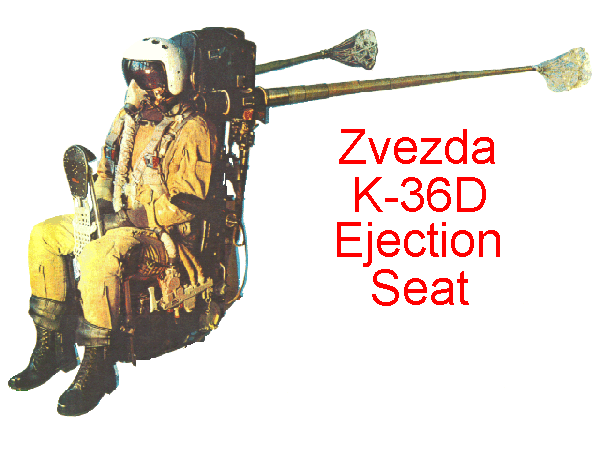The Ejection Site
K-36D Foreign Comparative Testing (FCT) Program

In a unique show of co-operation made possible by the end of the Cold war, The United States
and Russia have been involved in a testing program of the Russian made Zvezda K-36D
ejection seat. This seat is the standard seat of the Mig 29, SU-27 and many other
aircraft of the former Soviet Union. Zvezda has many years of experience in the egress
technology field. Seats from Zvezda have been in many different aircraft, and spacecraft.
The test program was jointly done in both Russia and in the United States to
take advantage of the unique test equipment in both hemispheres. In Russia, special test
facilities included the Big Vertical Catapult (BVC) tower, the Zvezda Aerodvnamic facility,
and the Flight Institute of Aviation MIG-25 Flying Laboratory, as well as sled
test facilities. In the United States, the primary test facility was the test track at
Holloman AFB, and the Multi-Axis Sled Ejection system. Testing was done under the control
of Armstrong Laboratories, Wright-Patterson AFB
The MASE is an improved rocket sled design that allows for adverse attitude
ejection testing on a sled track. The MASE allows for yaw positioning off axis
up to 20 degrees, some 45 degrees of pitch, and a roll capability of 90 degrees
either side of center with the capability of rolling during the ejection
of the test seat.
The BVC is a typical catapult tower used to validate the +Gz experienced on ejection.
The Zvezda Aerodynamic facility is a well designed 'wind tunnel' design which allows
for testing the effect of wind blast on a seat and occupant as it enters the
high speed airstream from the protective cockpit area. This facility is essentially
a set of rails that begins below floor level and rises up into the exhausted from
a 1.25 meter diameter wind tunnel with a wind speed of up to 1400km/hr.
The MIG-25 FLying Laboratory is a modified MIG-25 with the actual cockpit moved into
the radardome area and the regular cockpit instrumented to allow for a seat to
be fired in flight. Tests were accomplished at altitudes in excess of 55000 ft and
Mach numbers up to Mach 2.5 from the MIG.
More info to follow...



